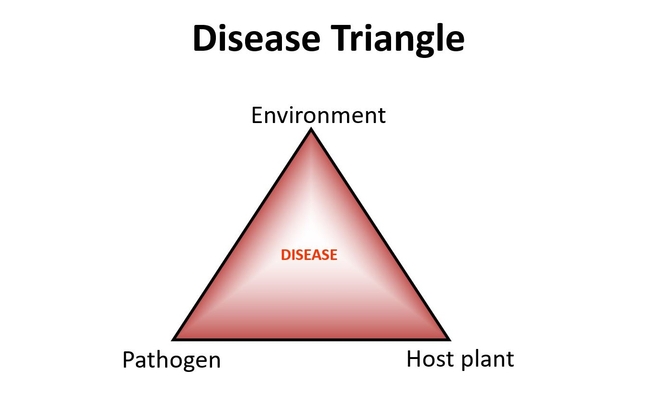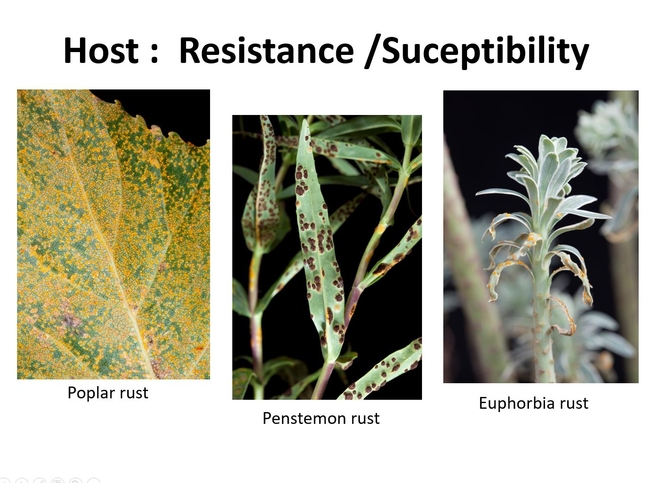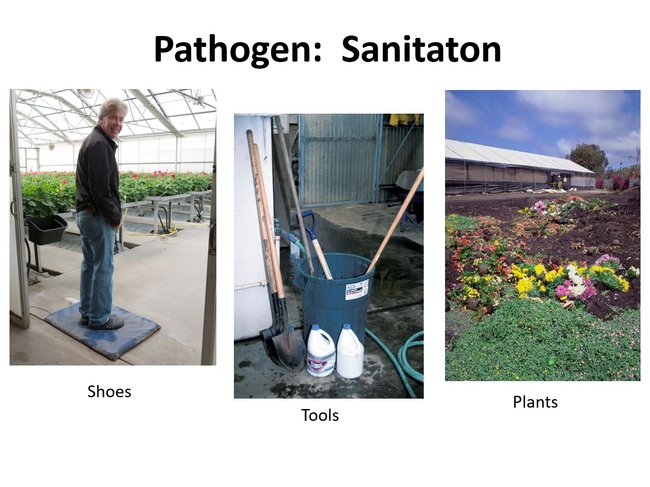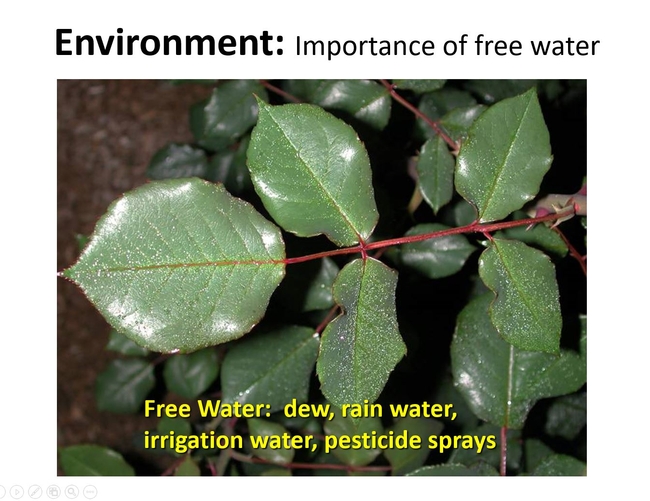
Posts Tagged: disorder
Disease Triangle
- Author: Steven A. Tjosvold
Plant diseases– their occurrence and severity– result from the impact of three factors: the host plant, the pathogen, and the environmental conditions. This is represented with the disease triangle.
If any one of the three factors is missing, the triangle is not complete, no disease will occur. Simply, plant disease will not occur if there is no viable pathogen, or no susceptible host plant, or the environmental conditions are not favorable. The severity of disease depends on the favorable level of each factor. How susceptible is the plant? How virulent is the pathogen? How conducive are the existing environmental conditions in supporting disease and pathogen spread?
The triangle also helps illustrate that the 3 factors are interacting with each other. The clearest example of this is how the environment factor interacts with the pathogen and host factors. Previous blogs illustrate the importance of leaf wetness on pathogen infection and disease severity. Long durations of free water on a susceptible plant can increase pathogen infection and disease severity. At the same time, the low- sunlight conditions, when these wet periods could occur (e.g. winter), could also be stressful to the plant, and the plant is less likely to mount defensive reactions to fend off infection.
Learn about the biology for any disease you are managing. Consider the disease triangle and the three interacting factors, and how management practices might help weaken or break the triangle's bond. For example, could you grow non-susceptible plant varieties or species? Could you eliminate the pathogen through judicious sanitation practices? Could you manage leaf wetness and relative humidity to create unfavorable environmental conditions for disease?
Could you grow non-susceptible plant varieties or species?
Although these three plant hosts all have rust diseases, each host is infected with a unique plant pathogen that attacks its specific host. In managing these diseases, a strategy of host resistance might be employed, where crops of non-susceptible hosts are rotated into the infested area. Conceivably these three hosts could be rotated.
Could you eliminate the pathogen through judicious sanitation practices?
Sanitation is a key management practice that employs the strategy of eliminating the pathogen from the growing area. Here, sanitizing shoes before entering the greenhouse. Cleaning soil from tools and sanitizing them before use. Properly covering and disposing of rogued plants or cut flowers (not shown here!).
Could you manage leaf wetness and relative humidity to create unfavorable environmental conditions for disease?
AND Then, can you add the 4th factor for Disease? That of TIME. It takes a certain amount of time for a given disease to show up. Some strike rapidly and others are chronic and persistent. Different time frames allow for different urgency for treatment. It's always best to remove one of the three Triangle factors before dealing with the Disease Pyramid which includes Time:
https://ucanr.edu/blogs/blogcore/postdetail.cfm?postnum=19842
The Disease Quadrangle
https://ucanr.edu/blogs/blogcore/postdetail.cfm?postnum=28845
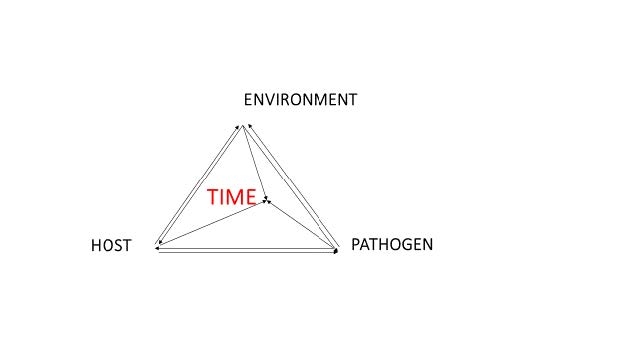
disease pyramid
Not Just Navels Split
It has been a struggle to get through these hot times and now it's getting cooler, it's even rained, and suddenly that beautiful citrus that has just broken color and is an orange globe splits. It's most common in navels, but all citrus that ripen in the fall – tight-skinned satsuma mandarins, early clementines, tangelos and blood oranges. With the hot summer, it seems that a lot of citrus fruit have accelerated their maturity and are ready, ripe and sweet right now, and maybe ready to split.
And that's the problem. Drought stress. Salt stress due to drought. Water stress due to miserly watering. A heat wave in July. And a weird fall with maybe rain and maybe no rain and is ¼ inch considered rain or just a dedusting? Irregular watering is the key to splitting this time of year. The sugar builds, the pressure to suck in water builds and the fruit has been held back by a constrained water pattern and suddenly some water comes and it goes straight to the fruit and Boom, it splits.
Years of drought, and a stressed tree are a perfect set up for a citrus splitting in fall varieties like navel and satsuma. The days have turned cooler and there's less sense on the part of the irrigator to give the tree water and suddenly out of nowhere, there is rain. That wonderful stuff comes down and all seems right with the world, but then you notice that the mandarin fruit are splitting. Rats? Nope, a dehydrated fruit that has taken on more water than its skin can take in and the fruit splits. This is called an abiotic disorder or disease. However, it's not really a disease, but a problem brought on by environmental conditions. Or poor watering practices.
Fruit that is not yet ripe, like ‘Valencias' and later maturing mandarins are fine because they haven't developed the sugar content and have a firmer skin. They then develop during the rainy season when soil moisture is more regular. Or used to be more regular. With dry, warm winters this may become more or a problem in these later varieties, as well.
Several factors contribute to fruit splitting. Studies indicate that changes in weather, including temperature, relative humidity and wind may exaggerate splitting. The amount of water in the tree changes due to the weather condition, which causes the fruit to shrink. Then with rewetting, the fruit swells and bursts. In the navel orange, it usually occurs at the weakest spot, which is the navel. In other fruit, like blood orange, it can occur as a side split, as seen in the photo below.
Proper irrigation and other cultural practices can help reduce fruit spitting. Maintaining adequate but not excessive soil moisture is very important. A large area of soil around a tree should be watered since roots normally grow somewhat beyond the edge of the canopy. Wet the soil to a depth of at least 2 feet, then allow it to become somewhat dry in the top few inches before irrigating again. Applying a layer of coarse organic mulch under the canopy beginning at least a foot from the trunk can help moderate soil moisture and soil temperature variation.
Once split, the fruit is not going to recover. It's best to get it off the tree so that it doesn't rot and encourage rodents.
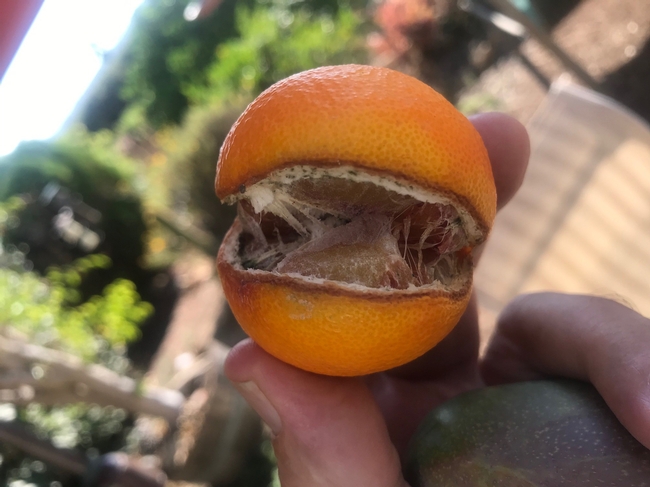
blood orange split
What Caused that Symptom???
Diseases, disorders and other plant problems are critical concerns for the wholesale nursery. These include biotic problems — caused by living organisms such as pathogens, nematodes, and insects and other arthropods — as well as abiotic problems — caused by factors such as temperature and moisture extremes, mechanical damage, chemicals,
nutrient deficiencies or excesses, salt damage and other environmental factors. Many plant problems, especially biotic problems, if not recognized and controlled early in their development, can result in significant economic damage for the producer. Therefore, timely and accurate diagnoses are required so that appropriate pest and disease
management options and other corrective measures can be implemented.
Definition of Plant Diagnosis and Steps
Diagnosis is the science and art of identifying the agent or cause of the problem under investigation. When one renders a diagnosis, one has collected all available information, clues and observations and then arrives at an informed conclusion as to the causal factor(s). Hence, plant problem diagnosis is an investigative, problem-solving process that involves the following steps:
- Ask and answer the appropriate questions to define the problem and
obtain information that is relevant to the case under investigation.
- Conduct a detailed, thorough examination of the plants and production areas.
- Use appropriate field diagnostic kits and lab tests to obtain clinical information on possible causal agents and factors.
- Compile all the collected information and consult additional resources and references.
- Finally, make an informed diagnosis.
Throughout this process compile all notes, observations, maps, laboratory results, photographs and other information. This compilation will be the information base for the present diagnosis and can also be a useful resource for future diagnostic cases. Keep an open mind as the information is analyzed and do not make unwarranted assumptions.
Distinguishing Abiotic and Biotic Problems
The first step is to determine whether the problem is caused by an infectious agent, and this can be difficult. Plant symptoms caused by biotic factors such as infectious diseases and arthropod pests are oftensimilar to damage caused by other factors. Leaf spots, chlorosis, blights, deformities, defoliation, wilting, stunting and plant death can
be common symptoms of both biotic and abiotic problems; therefore, the presence of these symptoms does not necessarily mean the problem is a disease. Some general guidelines for distinguishing abiotic and biotic
problems follow and are summarized in table 1.
Table 1 DISTINGUISHING ABIOTIC AND BIOTIC PROBLEMS |
||
Characteristics |
Abiotic |
Biotic |
Hosts |
often affects several species or plants of various ages |
often affects one species or cultivar of the same age |
Pattern of plant symptoms |
often related to environmental or physical factors or cultural practices; may be regular or uniform |
often initially observed in random or irregular locations |
Rate of symptom development |
relatively uniform, extent of damage appears similar among plants |
relatively uneven, time of appearance and damage severity varies among affected plants |
Signs |
no evidence of the kinds of pests or pathogens known to cause the current symptoms |
presence of insects, mites, |
Spread |
is not infectious, is not progressive, commonly caused by one incident and does not spread |
infectious, spreads on host over time if environmental conditions are suitable |
Recurrence |
possibly previously associated with current or prior environmental conditions or cultural practices |
possibly caused by pests that |
Adapted from Table 18, ANR Pub 3420 |
||
Biotic problems. Identifying biotic problems is sometimes facilitated if signs of a pathogen, primarily the growth of a fungus, are present. The most obvious examples of such signs are the mycelium and spores produced by rusts and powdery and downy mildews. However, in other cases nonpathogenic fungican grow on top of damaged plant tissues and appear to be signs of a pathogen, resulting in possible misdiagnoses.
Biotic problems often affect one species or cultivar of the same age and typically are initially observed in random or irregular locations; symptoms appear at varying times, and severity varies among affected plants. Biotic problems are infectious, spreading when environmental conditions are favorable, and may be associated with pests that have affected the crop. This infectious aspect is important, as biotic diseases will many times be progressive and continue to affect
additional tissues and more plants.
Abiotic problems. In contrast to biotic factors, abiotic problems often affect several species or plants of various ages; typically, damage is relatively uniform, doesn't spread and is often not progressive. Abiotic problems are not associated with pests. They are often caused by a single incident and are related to environmental or physical factors or cultural practices. Once the responsible factor has dissipated and is no longer affecting the plant, the plant may grow out of the problem and develop new, normal appearing foliage.
Diagnosing Biotic Problems
Infectious diseases. To confirm if a problem is caused by a pathogenic fungus, bacterium, nematode, or virus, it is often necessary to have symptomatic tissues analyzed by a trained horticulturalist or plant pathologist. Such experts will attempt to microscopically observe the agent and recover it, if culturable, through isolation procedures. Lab analysis is particularly important to determine if multiple pathogens are infecting the plant. A downside is that obtaining a diagnosis from lab analysis is not a fast process. However, quick test kits (fig. 1A) are available that can be used to rapidly identify many common diseases in the field.
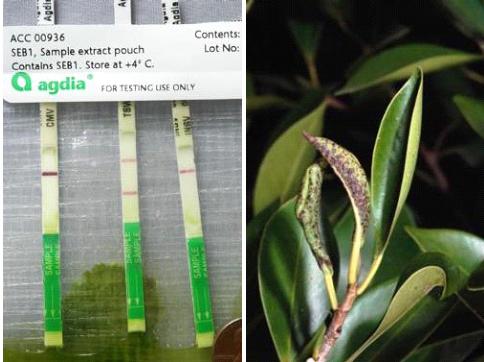
A B
Fig.1. Diagnosing biotic
problems. Plant pathogens can sometimes be rapidly diagnosed using
commercially available quick tests, such as these test strips for
viruses (A). Arthropod pests such as Cuban laurel thrips (shown here on Ficus) cause feeding damage, which can help in pest identification (B). Photos: S.T. Koike (A), J. K. Clark (B).
It is worthwhile to emphasize that diagnosing plant diseases requirescareful examination of the entire plant specimen. Symptoms on leaves, stems, or other above ground plant parts might lead one to suspect that afoliar pathogen is involved. However, these symptoms could also resultif the roots are diseased. Therefore, it is important to conduct a
complete examination of the symptomatic plant.
Because biotic diseases are caused by living microorganisms, the collecting and handling of samples is particularly critical. Samples that are stored for too long a time after collecting or that are allowedto dry out or become hot (if left inside a vehicle, for example) will sometimes cause the pathogen in the sample to die, making pathogen recovery and identification impossible. Plants that have been diseased for a long time and that are in the late stages of disease development will often be colonized by nonpathogenic saprophytic organisms. If these tissues are collected, it will be difficult to recover the primarypathogen of concern because of the presence of these secondary decay organisms. Root samples should be collected carefully as diseased rootsare sometimes difficult to dig out of the potting mix or soil, are
usually colonized by the pathogen as well as secondary agents, and are very sensitive to high temperatures and drying conditions.
Arthropod and other invertebrate pests. Insects,mites, slugs and snails cause damage while feeding on the plant (fig. 1B). Feeding damage is usually associated by the type of feeding characteristics and mouthparts of the insect or pest. For example, mites and insects such as whiteflies, aphids and mealybugs have tubular sucking mouthparts that suck plant fluids, causing buds, leaves, or flowers to discolor, distort, wilt, or drop. Thrips have rasping mouthparts that result in dried out, bleached plant tissue. Caterpillars, weevils, snails and slugs have chewing mouthparts that
make holes and cuts in foliage or flowers. They can also prune plant parts and sometimes consume entire plants.
If present, these pests are visible with the naked eye, a 10 X hand lens, or stereomicroscope, all depending upon their size. An assessment of whether the identified arthropod or invertebrate matches the plant damage it is associated with must be determined. Sometimes the identified arthropod or invertebrate may not be the sole problem or
could, in fact, be a beneficial organism or insignificant pest.
Aphids, whiteflies, thrips, leafhoppers and some other insects that suck plant juices may vector pathogens such as viruses and phytoplasmas (and to a lesser extent fungi and bacteria). They can feed on infected plants, acquire the pathogen, feed on healthy host plants and transmit the pathogen to the new host. The insects do not necessarily have to bepresent in large numbers to cause a significant disease outbreak. The insect vectors are not always present at the same time the disease symptoms are being expressed.
The excrement and byproducts from these pests can also provide clues that the pests have been or are actively present. Caterpillars and other chewing pests produce dark excrement or droppings. Greenhouse thrips and plant bugs produce dark, watery, or varnish-like droppings onfoliage. Aphids, whiteflies, soft scales, and some other sap-sucking insects excrete excess plant fluids as honeydew, a sticky sap, which provides a medium for the growth of sooty mold.
Diagnosing Abiotic Problems
Nutrient deficiencies and toxicities. Nutrientdeficiencies and toxicities reduce shoot growth and leaf size, cause leaf chlorosis (fig.2A), necrosis and dieback of plant parts. However, nutrient deficiencies cannot be reliably diagnosed on the basis of symptoms alone because numerous other plant problems can produce similarsymptoms. There are general symptoms that can be expressed by deficiencies of nutrients but usually leaf and/or soil samples are
needed to confirm the problem.
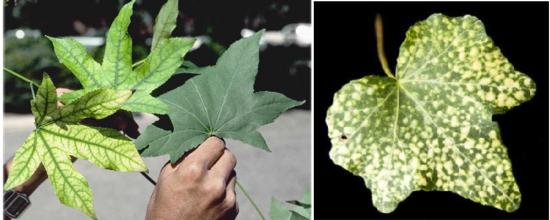
A B
Fig. 2. Examples of abiotic problems. Iron deficiency on sweet gum (Liquidambar styracifolia) showing interveinal chlorosis (A). Chorotic spots on Hedera caused by a miticide application at a higher dosage rate than specified on the pesticide label (B). Photos: E. Martin (A), S. A. Tjosvold (B).
Herbicide, insecticide and fungicide phytotoxicity. Herbicidesused to control weeds in crops or in non-cropped areas sometimes injureornamental crops when they are not used in accordance with label instructions. Examples include when an herbicide is used in or around sensitive non-target crops, when an herbicide rate is increased above tolerable limits, or when an applicator makes a careless application. By understanding the mode of action of the herbicide, one can determine if the symptom fits an herbicide application. Herbicide detection in affected plants is possible with the help of a specialized laboratory but the analysis can be expensive. To minimize the cost of testing, the laboratory will need to know the suspected herbicide or its chemical group to narrow the analysis. Pesticides and fungicides occasionally cause obvious plant damage.
Symptoms can vary widely. Generally, flower petals are more susceptible to damage from pesticide applications than are leaves. The younger and more tender the leaves the more susceptible they are to pesticide applications. Hot weather can exacerbate the damage the chemicals cause. Pesticides that have systemic action can have a more profound effect. Some active ingredients can adversely affect the photosynthetic mechanism or other physiological processes and can resulti n a general leaf chlorosis, interveinal chlorosis, leaf curling and stunting. Emulsifiable concentrate (EC) formulations, soaps and oils can adversely affect the waxy surface layer that protects the leaf from desiccation. Applications with these products can result in the loss ofthe shiny appearance of a leaf, leaf spotting and necrosis. Pesticidesapplied as soil drenches can cause poor germination, seedling death, or
distorted plant growth.
Check label precautions against use on certain species. Make sure thepesticide is not applied more frequently or at a higher rate (fig. 2B) than recommended, or that the pesticide is not mixed with incompatible pesticides. When in doubt as to whether the plant species is sensitive to the pesticide, spray a few plants and observe them for several days to a week for any signs of damage before spraying any more of the plants.
Physiological and Genetic Disorders
There are numerous disorders that can occur because of environmental extremes — too much or too little of an environmental element such as light, temperature, water, or wind. Sunburn is damage to foliage and other herbaceous plant parts caused by a combination of too much light and heat and insufficient moisture. A yellow or brown area develops on foliage, which then dies beginning in areas between the veins. Sunscaldis damage to bark caused by excessive light or heat. Damaged bark becomes cracked and sunken. Frost damage causes shoots, buds and
flowers to curl, turn brown or black and die. Hailstones injure leaves,twigs, and in serious cases even the bark. Chilling damage in sensitive plants can cause wilting of foliage and flowers and development of dark water-soaked spots on leaves that can eventually turn light brown or bleached, and die. Physical and mechanical injury can occur when plants are mishandled during transport or routine cultural practices. Wounds might serve as entry sites for plant pathogens and can attract boring insects to woody stems.
In closed environments such as greenhouses and nursery storage areas,plants can be exposed to toxic levels of ethylene gas. Sources of ethylene include improperly functioning or unvented greenhouse heaters; exhaust from engines of forklifts and vehicles; cigarette smoke; damaged, decaying, or dying plants; and ripe or decaying fruit. Toxic levels of ethylene gas can cause premature abscission of flower buds, petals (fig. 3) and leaves. Other symptoms include wilted flowers, chlorosis, twisted growth or downward bending of stems and leaves and undersized or narrow leaves.
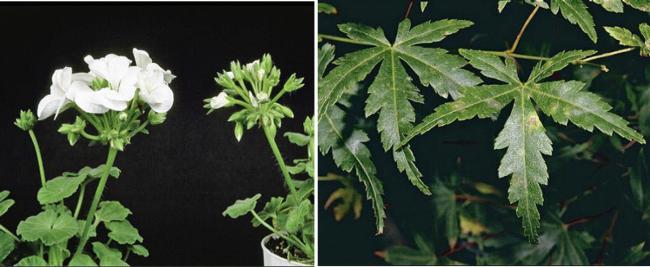
A B
Fig. 3. Poor air quality can
lead to physiological disorders. Shattering (petal drop) on geranium was
caused by plant exposure to low levels of ethylene in the greenhouse or
during postharvest storage (A). Yellowish and brownish patches on
Japanese maple leaves are damage caused by ozone (B), an outdoor air
pollutant. Photos: J. K. Clark.
Outdoors, exposure of nursery plants to air pollutant gases such as ozone (fig. 3), carbon monoxide, nitrous oxides and sulfur dioxide can cause damage. Typical symptoms vary widely, but include slow growth anddiscolored, dying, or prematurely dropping foliage. Damage is often found where plants are located near sources of polluted air such as near
freeways or industries or where weather and topography concentrate the pollutants.
Sometimes plants or plant shoots exhibit an unusual and sudden changeof color producing discrete markings of variegation. For example, a plant with entirely green leaves suddenly produces a shoot that has leaves with edges lacking green pigment, stripes, or blotches. A new shoot such as this is probably a chimera (fig. 4). It is produced when a genetic mutation occurs in a specific region of the growing tip resulting in a section with genetically different cells. The ostensible result of the genetic change is dependent on the arrangement of the genetically different cells in the shoot tip and their expression. This can lead to sometimes bizarre variegation forms or sometimes forms thatare quite desirable. Sometimes variegation can be caused by viruses. Viruses usually cause non-uniform chlorosis, such as mosaics, while
chimeras usually produce patterned forms such as variegation of color onleaf margins, stripes, or complete loss of pigment. Some viroids may also cause bleaching of pigments in leaves; such symptoms, however, are generally produced throughout the plant and are not restricted to a single shoot. Some nutrient disorders can cause variegation but these disorders usually do not arise from a specific shoot as with chimeras.
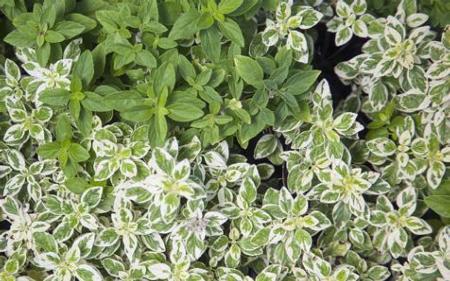
Fig. 4. Genetic disorder.
Growing points with variegated leaves can sometimes arise spontaneously
from some species such as this Origanum. Genetic variants such as this are sometimes confused with plants with virus disease or nutrient deficiency symptoms. Photo: S. A. Tjosvold.
Steve Tjosvold is Environmental Horticulture Advisor and
Steve Koike is Plant Pathology Farm Advisor, UC Cooperative Extension,
Santa Cruz and Monterey counties.
This article was condensed from: Diagnosing Plant
Problems, Chapter 11. In Newman, J. (ed) Container Nursery Production
and Business Management. Univ. of Calif. Agric. and Nat. Resources.
Publication 3540. Richmond, CA.
References
Boxer P, Sandmann G. 1989. Target sites of herbicide action. Boca Raton, FL: CRC Press.
Costello L, Perry E, Matheny N, Henry M, Geisel P. 2003. Abiotic
disorders of landscape plants: A diagnostic guide. Oakland: University
of California Division of Agriculture and Natural Resources Publication
3420.
Derr JF, Appleton BL. 1988. Herbicide injury to trees and shrubs: A
pictorial guide to symptom diagnosis. Virginia Beach, VA: Blue Crab
Press.
Dreistadt SH. 2001. Integrated pest management for floriculture and
nurseries. Oakland: University of California Division of Agriculture and
Natural Resources Publication 3402.
Eagle, DJ. 1981. Diagnosis of herbicide damage to crops. New York, NY: Chemical Publishing Co.
Grogan RG. 1981. The science and art of plant disease diagnosis. Annual Review of Phytopathology 19:333–351.
Ratzinger EJ, Mallory-Smith C. 1997. Classification of herbicides by
the site of action for weed resistance management strategies. Weed
Technology 11:384–393.
Schubert TS, Breman LL. 1988. Basic concepts of plant disease and how
to collect a sample for disease diagnosis. Plant Pathology Circular No.
307. Florida Department of Agriculture and Consumer Services, Plant
Pathology Circular No. 307.
Sharma MP. 1986. Recognizing herbicide action and injury. Alberta Environmental Centre, Alberta Agriculture. Agdex 641–647.
Shurtleff MC, Averre CW. 1997. The plant disease clinic and field
diagnosis of abiotic diseases. St. Paul, MN: American Phytopathological
Society Press.
Stewart TM, Galea VJ. 2006. Approaches to training practitioners in
the art and science of plant disease diagnosis. Plant Disease
90:539–547.
Tickes B, Cudney D, and Elmore C. 1996. Herbicide injury symptoms.
Tucson, AZ: University of Arizona Cooperative Extension Publication No.
195021.
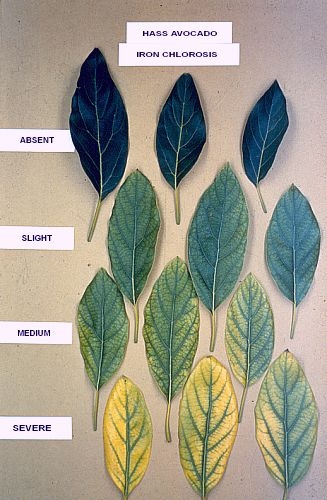
avocado chlorosis
Honeybees are having a worse time than ever
By: Carey Gillam, Reuters
Honey bees, critical agents in the pollination of key U.S. crops, disappeared at a staggering rate over the last year, according to a new government report that comes as regulators, environmentalists and agribusinesses try to reverse the losses.
Losses of managed honey bee colonies hit 42.1 percent from April 2014 through April 2015, up from 34.2 percent for 2013-2014, and the second-highest annual loss seen, the U.S. Department of Agriculture said in a report issued on Wednesday.
"Such high colony losses in the summer and year-round remain very troubling," Jeff Pettis, a USDA senior entomologist, said in a statement.
The 2014-15 yearly loss was down slightly from the 45 percent annual loss for 2012-2013 but well above the prior two years of annual measurements and above the benchmark of 18.7 percent that is considered economically unsustainable, USDA said.
Millions of honey bees are relied on to pollinate plants that produce a quarter of the food consumed by Americans. Beekeepers travel the country with managed hives to help the process.
But over the past few years, bee populations have been dying at a rate the U.S. government says must be addressed, and finding an answer has become a politically charged debate.
Beekeepers, environmental groups and some scientists blame a class of insecticide known as neonicotinoids, or neonics, used on crops such as corn as well as on plants used in lawns and gardens.
But Bayer, Syngenta and other agrichemical companies that sell neonic products say many factors such as mite infestations are harming the bees.
The White House has formed a task force to study the issue, and some lawn and garden retailers have been cutting use of neonics.
The Environmental Protection Agency is requiring a series of studies on neonic effects on bees and plans to issue the first of a series of assessments later this year.
The USDA report issued on Wednesday said colony losses were 23.1 percent for the 2014-15 winter months, typically the higher loss period. The 2014 summer loss of 27.4 percent marked the first time summer losses exceeded winter, and marked a surge from the 2013 summer loss of 19.8 percent, USDA said.
The results are considered preliminary and are based on survey responses from about 6,100 beekeepers managing 400,000 colonies, USDA said. Those beekeepers represent nearly 15.5 percent of 2.74 million U.S. bee colonies. A more detailed report is to be published later this year, USDA said.

honeybee at hive
Satsuma Rind Disorder
There was a lot of odd looking, water-soaked Satsuma fruit showing up this year along the coast. It was showing up as late as March since fruit can hang so much longer along the coast than the Central Valley and hotter areas. It turns out its an abiotic issue and is more associated with the cooler, coastal environment. Recently a "Gold Nugget" mandarin came in that had a very similar look to the rind. This variety doesn't have immediate satsuma parentage, but who knows what is in its past. The disorder is most commonly associated with cool, foggy or rainy conditions. In the fall we had those conditions and maybe that's what set it off. Later, secondary fungi move in to colonize, the depressions that first occur.

mandarin rind disorder

